
Lionel Sabatte
“In the Middle Ages visual communication was, for the masses, more important than writing. But Chartres Cathedral was not culturally inferior to the Imago mundi by Honorius of Autun. Cathedrals were the TV of their times, and the difference with our TV was that the directors of the medieval TV read good books, had a lot of imagination and worked for the public good.”
Umberto Eco
“There is gold paint, but Rembrandt didn’t use it to paint a golden helmet.”
Wittgenstein
“Now fashion, as we know, is a language: through it, through the system of signs it sets up, no matter how fragile this may seem, our society—and not just that of women—exhibits, communicates its being, says what it thinks of the world; so, just as the gemstone basically expressed the essentially theological nature of ancient society, so jewelery today, as seen in shops and in fashion magazines, merely follows, expresses and signifies our times—having originated in the ancestral world of the damned, the piece of jewelery has in one word become secularized.”
Roland Barthes
“By definition, as a Prime Minister I cannot be a liar.”
Sylvio Berlusconi ( Italian Radio National Broadcast, 2006)
“One may smile and smile and be a villain…”
Shakespeare (Hamlet)
There was a great deal of attention given to Melania Trump’s Christian Louboutin (we think) stilettos as she walked off to view, with her husband the President, the suffering and destruction from Hurricane Harvey. Most of the response that I read was to dismiss this as a distraction, or even in some cases, to see it as a kind of misogynist bullying. This idea of distraction has gained a lot of momentum over the last dozen or so years. I’ve used that term and idea a number of times, for of course on a certain level this is the society of distraction. Attention is increasingly short lived. Yet I am coming to feel the concept of distraction is itself a distraction.
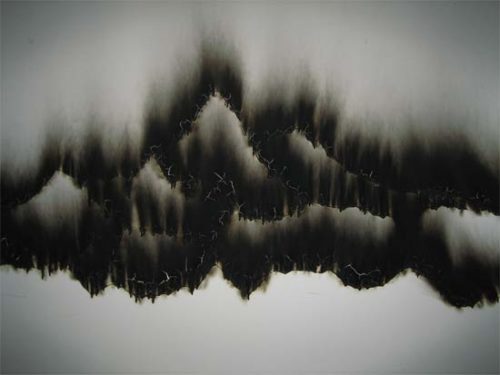
Christian Jaccard
I find that either everything is a distraction or nothing is a distraction. By which I mean, the reality of the damage to Houston, the criminal lack of foresight, and the de facto violence, then, of the state toward to the poor to be the reality that must be buried.
“Along the petro-chemical zone, refineries flooded, pipelines ruptured, chemical plants exploded, and toxic waste sites were swamped. An early estimate, almost certainly low, calculated that two million pounds of hazardous chemicals had been released into the air during the flood by the big oil companies alone. Two oil tanks ruptured spilling 30,000 gallons of crude into the floodwaters. Another storage tank released 9,500 gallons of highly toxic wastewater. These were only the highlights in a state where regulators are charged with concealing not exposing such incidents.”
Jeffrey St.Clair
Concealment and exposure. The concealment of the global violence against the poor is the logic of Capital. This is what the ruling class does. Conceal. Manufacture mechanisms of concealment. But in a society of the spectacle, the violence surfaces in other ways. Melania Trump’s shoes were one such surfacing. The idea of fetishism is then a topic.
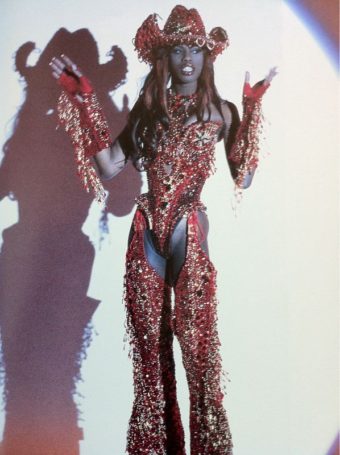
Theirry Mugler (Cowboy Girl).
“Characteristics which had appeared mysterious because they were not explained on the basis of the relations of producers with each other were assigned to the natural essence of commodities. Just as the fetishist assigns characteristics to his fetish which do not grow out of its nature, so the bourgeois economist grasps the commodity as a sensual thing which possesses pretersensual properties.”
Karl Kautsky
But it is not just concealment. It is a kind of desublimation; the channeling of real violence into sentimental narratives of redemption or promise. I can only wait for the stories of ‘the courage of those rebuilding their homes after Harvey’ etc. Narratives of the indomitable human spirit, and all of these will be predicated on the voyeurism of the white bourgeoisie. So it may be that actually those stilettos are the least distracting of stories. For they are pregnant (sic) with meaning.
“There was no escaping from this law even during the Royal Wedding. However, anyone watching the broadcast will have noted that the horse droppings were neither dark nor differentiated but were also a pastel shade, between yellow and beige, shiny and in harmony with the surrounding ladies’ dresses. One read later (and it wasn’t hard to imagine) that the royal horses were fed pills for a week so as to guarantee dung of telegenic colouring. Nothing could be left to chance, everything was ruled by the television coverage.”
Umberto Eco

Peter Stampfli
Those stiletto heels are the daggers or spears of non utility, of the ruling class in its refusal to work, and more, refusal to participate in the visual coding of labor. The fashion worlds relationship to sado-masochism is rather obvious at this point. There are numerous examples to be mined in film history on the relationship of denial and severity in female sexual allure. Catherine Deneuve (at one time the face of Chanel) was all straight lines and angular planes as Severine in Buneul’s Belle de Jour — as Stella Bruzzi notes, hers is a refusal of sensuality, it is all fastened buttons and perfect coordination. There is no ornamentation or flamboyance. This is worth examining in the context of post fascist Europe. And it is worth noting in Chanel’s pro Nazi sympathies (and boyfriends). For this is part of the class dynamic one sees distilled in those Louboutin stilettos. Bunuel was perhaps only second to Pasolini in his decontructing of fascist style.
Bruzzi also notes that those moments of personal crisis, for Severine, the camera moves to close ups of her shiny shoes pacing to and fro. Bunuel sensed that repression lied at the heart of the fascist psyche. The anal sadistic character armoring that Reich spoke of. Vogue, the voice of the haute couture industry, chastised Ms. Trump as well. Because they serve to protect ruling class taste and Trump is forever violating the canons of taste. And that ruling class taste is a kind of symbol for ruling class ideology. I suspect the old guard money really does experience Trump as anathema to their ideal world order. Trump, the man who cant get his tie length right, who like Berlusconi, works overtime at the tanning salon, or did before his presidency. His new pallor speaks to the stress of the office.
Barthes touched on something else, however. The quality of clothes when not being worn. The sense of schizophrenic fantasy that is the decapitated body, the limbless body. For attire is never static.
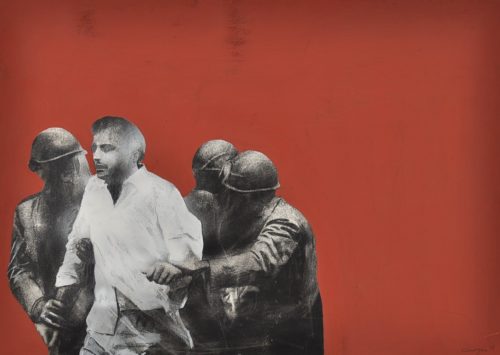
Rafael Canogar
“What fearful power, what awesome divinity is repetition! “
Robert Musil
There is something intuitive that connects fashion with the death instinct. And fashion with fascism. That clothes both hide and reveal, or rather hide and ask to be seen. Vogue scolding Melania is petit bourgeois morality, but the real message was fear of the image. The recent U.S. nazi rallies, with KKK members (half of whom are undercover cops) are relatively small, but white supremacist sensibility and resentment is massive. But note, too, that undercover cops infiltrate all sides today. In the age of surveillance the apparatus of policing employs disguise more than ever. The desire that nobody be what they appear. Lurking behind the control is the destabilizing of the self. Behind the oscillating subject positions that are increasingly subsumed by the voyeurism of the spectacle, there is something morbid.
“The pressure of reified bourgeois culture incites flight into the phantasm of nature, which then ultimately proves to be the herald of absolute oppression. The aesthetic nerve quivers to return to the stone age.”
Adorno

Belle de Jour (Luis Bunuel, dr. 1967)
The narratives of mainstream media reflect a sort of unconscious wish for oblivion, for none of it to be true. The desire is to start over, and hence the endless reconstruction stories seen from Hollywood. From Zombies to aliens, to fantasy worlds, the common thread is one of a new beginning. But there is another trend in popular entertainments and that is a more illusive factor or trope; it has to do with the annulment of voyeurism. The two conflicting registers of mass culture, then, are the voyeur and the blind. And buried within this tension is the tendency toward dismissal. Oh those stilettos are not important. Oh this is just propaganda. And both are true. And both are not true. So blatant is the lying of the government today that literally nothing anyone in office says can be believed. You cannot believe them when they say their name.
In House of Games, Robin Wright as the first lady is seen, often from a low camera angle, pacing through the White House in stiletto heels (or doing most anything, it’s in stilettos..and verified as Loubutin). The character of Claire Underwood, then, is both ersatz villain, and aspirational object of achievement. Mark White Wigley, whose book White Walls, Designer Dresses, remains a singularly cogent exploration of fashion’s influence on modernism in architecture, but also on the modern system of aesthetic values, noted that what was learnt was that function was that which fashion was not (to paraphrase a bit). Utility again. For Claire Underwood is expressing that separation from daily life that America’s anointed must always embody.

Roman Moriceau (serigraphie).
“Fashion, grooming, new clothes, and how we make ourselves appear to others exhibit the utopian potential of transforming us into something better.Perceiving the utopian potential of advertising, Bloch recognizes that it invests magical properties into commodities, which will produce allegedly magical results for the customer.”Shop-windows and advertising are in their capitalist form exclusively lime-twigs for the attracted dream birds”. To be sure, the promises of advertising and consumer culture are often false promises and often produce false needs, but their power and ubiquity shows the depth of the needs that capitalism exploits and the wishes for another life that permeate capitalist societies.”
Douglas Kellner (on Ernst Bloch)
Bloch, of course, looked at the unconscious as something not-yet-appearing, as opposed to the no-longer-appearing. It was linked to his desire for Utopia. This was an edge or perhaps tier of the unconscious that Bloch felt Freud actually was describing, without fully knowing it. For Bloch, there was a great power in folk cultures and traditions, though he was always acutely aware of the manipulation of volkish archaic fantasies by National Socialism. For Bloch, Jung was a ‘frothing fascist’ because he encouraged a return to irrationalism and…“..the neurosis, particularly that of modern, all too civilized and conscious man, derives according to Jung precisely from the fact that men have emerged too far out of what is unconsciously growing, outside the world of ‘elemental feel-thinking.’ Here Jung borders not only on the fascist version of Dionysus…” but also, he says, of Bergson… and I’d add Heidegger.
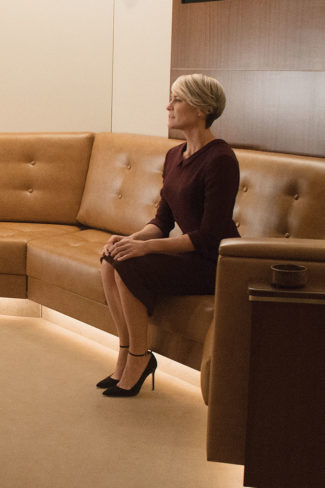
House of Cards (Netflix 2013)
“In the world only reification, which keeps a firm hold on individual moments of process and anchors them as facts, suits the empiricist, and he stands and falls by it.( ) Whereas imagination,as soon as it appears concretely, knows how to visualize not only sensory abundance, but also the mediation-relations in and behind the immediacy of real experience. Instead of the isolated fact and the superficial context of abstract immediacy which is likewise isolated from the whole, the relation of appearances to the whole of their epoch and to the utopian Totem located in process now emerges. Art becomes knowledge with the help of imagination of this kind, namely through telling individual images and overall pictures of a characteristically typical kind; it pursues the ‘significant aspect’ of appearances and executes it. Science, with the help of imagination of this kind, grasps the ‘significant aspect’ of appearances through concepts, which never remain abstract, never allow the phenomenon to fade, let alone be lost. And the ‘significant aspect’ is in art and science the particular aspect of the general, the respective instance for the dialectically open context, the respective characteristically typical figure of the Totem. And the actual Totem, this dimension in which even the epochally grasped whole of all epochal moments is itself again a moment, shows itself precisely in broadly mediated great works only on the horizon, not in an already thoroughly formed reality.”

Luis Feito
Never mind the knotty language of the translation — something one has to wade through if reading Bloch in English — the empiricist, and not the scientist for Bloch, and the naturalist, lack a certain interior space that Bloch calls the horizon. And it is this which stops that reified empiricist engaging with any sense of change. Or that change may indeed be the point of Utopia. The anal sadistic, the fascist psyche, is one that sees the goal as completion. The insistence on goals and the goal once reached signals the end. Now I have noticed a trend in mass entertainment narratives, a rather dramatic increase, actually, in depictions of the happy family and the happy slave. What Bloch fifty years called ‘the dancing work animal’ and the ‘castrated husband’. But there is a new sort of revanchist version of the *normal* family and with that comes a number of stories about identity issues of youth. But the family is now depicted as even more traditional than those 50s family half hour comedies. And a number of dramas center around disruptions of the normal. Usually identity fulfillment restores equilibrium. What you never see are families torn by the crushing weight of financial anxiety and work failure. If a character is, say, laid off, the narrative will center on the restoration of his previous job in another guise. A newer better job appears etc. You do not see terminal unemployment much as you rarely if ever see the working poor and their lack of opportunity. Lack of opportunity is one of those no-no’s in Hollywood storytelling.
The normal includes marriages of many decades often (and increasingly same sex marriages) without much turmoil or actual change (yet still sexually fulfilled). A kind of backdrop of stasis is a given. The disruption comes from outside (terrorists, zombies, alien disease etc). Bloch had another insight, regards how sport allows a moment of actual competition…even for the spectator. Especially perhaps for the spectator. Fantasy football leagues and the like allow for both an experience of power and skill, but also for hope.
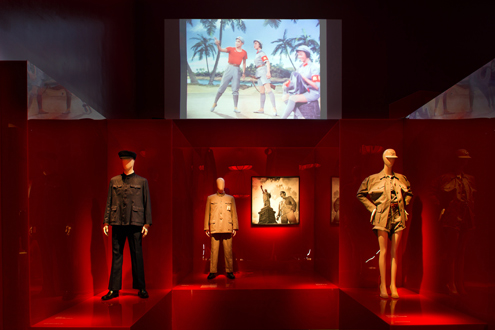
Metropolitan Museum, NYC (Through the Looking Glass, China. Gallery 30, the Mao Jacket).
The rise of advertising and then marketing transformed the shop window display of only a half century ago into a more complex manipulation of aspirational desire, and unintended frustration. Screen narratives are always partly advertising lifestyle fantasies. An adjusted handsome yet castrated husband, a perfectly compliant trophy wife, an assortment of well adjusted friends, and cutting through all of it is real estate. The looming access to the playgrounds of the one percent is the foundational dream of the white bourgeoisie today. The screen life of most at least nominally educated people in the West is one constantly establishing and then re-establishing the abundance of Capitalism. And it is another insight of Bloch’s that such displays of bounty always hide their owner. Gone is the discussion of price, because there is nobody to have that discussion with. It is de facto unseemly to haggle over price. The act of buying is one of those contemporary rituals of piety and humility. The only time the bourgeoisie today is humble is in the act of purchasing.
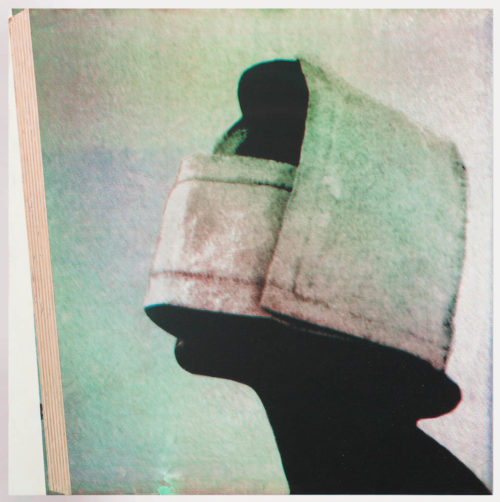
R. H. Quaytman
For what is the goal of self help today? Of therapy? The first answer is to reduce pain and suffering. But the second and third reasons are self advertisement. There is nobody living under Capitalism that does not participate. The act of not participating is, of course, participating. Even the isolated survivalist is participating. In manufacturing an image, is put into the spectrum of acceptability that the commodity society demands.
The authority apparatus asks for a contradictory self to be put on display; the anonymous citizen. Surveillance recognizes unusual (sic) behavior and red flags it. If you visit airports you must be anonymous. The rise of CCTV has meant the individual must be both the same as everyone else while still clinging to their individualism. The fascist aesthetic then has migrated from the simple regressive Nazi volkish mythology to the Ku Klux Klan hoods that equally called forth primitive states of purity, to a newer form of anality, one that haute couture has instinctively responded to. The antiseptic sado masochist. The fluid free S&M idol. The smooth surfaces and perfectly coiffed hair, the merging also of elements from the lower rungs of privilege — the Christian right has instilled a kind of normalizing of the Sunday school teacher as a figure of power. And all these contradictions speak to the sense of an empire crumbling.
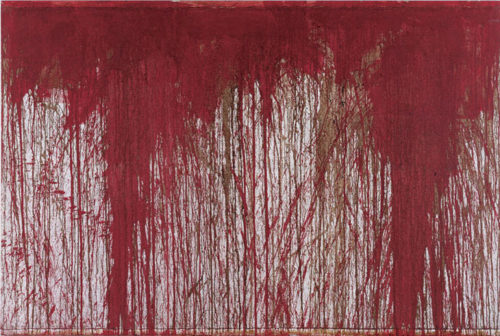
Herman Nitsch
There is also an ascendent sort of yuppie/hipster demographic that needs and looks for assurance that their individuality is not being eroded somehow. Specialist retailers for everything from socks to mustache wax to luxury food fetishes. And along with it the cottage industry in books of instruction. How to host a wine tasting party. How to make small talk at parties. And all of these, and the list is endless, take their place next to books (or internet courses) on how to remove wrinkles, etc. etc. etc. And even the offspring of MFA writing courses have taken on the strategies of self help manuals. Since art’s value is so reduced today the desire to BE an artist means one has to manage expectations and manufacture compensatory goals for personal fulfillment. The entire arena of self help and therapy (and I should make clear there are many very good therapists, its just that there are many more bad ones) has taken on a quality of supervised and administered satisfactions. So fragile is the experience of satisfaction today that many people are constantly searching for validation not just of their special talents or abilities, but just that they are not losers. The phenomenon among the privileged white classes of second careers is testament to this. If the first arc of career doesn’t pan out, well, one can always become something else. And therapist has sort of replaced manicurist — for the haute bourgeoisie anyway. For men the second career may also be therapeutic, but it is more likely to be some form of waiting on and servicing the 1%. Specialist services to the rich is actually treated as noble in Hollywood film and TV.
The trend in Hollywood from forty yeas ago was the making heroic of insurance salesmen and the like. This has simply intensified. For there is such acute desperation out there. And for the white working class there is a special layer of frustration born of lack of access to these specialized self improvements. It becomes the feeding ground for fascist sensibilities.

The Lykaon Painter, Odysseus Meets Elpenor in the Underworld .450-425 BC
Adorno and Horkheimer saw the origin of reason in the cunning born of sacrifice. And progress came in the form of domination and control, but retained the sacrificial and hence progress always is recreating a mythical past world of sacrifice, a world from which escape was necessary. The desire for completion is then a part of this dialectic.
“The self is precisely the human being to whom the magical power of substitution is no longer attributed. The establishment of the self severs that fluctuating unity with nature that the sacrifice of the self claimed to achieve.”
Robert Hullot-Kentor
The world becomes reduced to that which is to be controlled — that is the paradox of sacrificial reason (according to Adorno). So this always teetering vulnerable sense of identity is prone to strategies of domination that promise security and absoluteness.
“Only by first becoming a novel does the epic become a fairy tale.”
Adorno
The novel is today the TV miniseries. And one of the hallmarks of contemporary TV is the inability to actually tell a story. Partly this is the product of economic uncertainty. Shows never know when they will be renewed or cancelled. But either way the sense of lack becomes fixed in narratives. The audience experiences narratives with the distance of a real estate appraiser. What are the ratings? You think HBO (Netflix, Showtime, Fox et.al.) will do a second season? The contemporary subject allows for no abandon. No immersion. Couple that to the fact that liberal Hollywood is profoundly mediated by the Pentagon and State Department, and one finds the unspoken premise of everything is white supremacism and U.S. Imperialist virtue. Gilles Delueze rather impenetrable essay on Freud’s Death Instinct is nonetheless perhaps my favorite bit of his writing. And it is because there is something quite correct in how sadism and masochism are treated there. For Deleuze pain is only an effect; there is no direct link to sadism and masochism but rather this formation comes out of the resexualization of Thantos. Repetition is then autonomous. Eros is sacrificed, in a sense, and desexualized. The contemporary sense of panic I feel on a social level seems, one intuits anyway, connected to this autonomous principle of repetition. And one sees it everywhere. So, the adaptive fixation on surface is expressed in reflexive creations of the same. Except the same is never quite the same, another thing Deleuze seems to agree about.

Manolo Valdes
“Fashion-magazine layouts have a particular feel to them. We know it well: stylized, blank, alluring in an anonymous way, suggestive of sex, but devoid of sensuality or personal emotion. The photographs draw us in, but the models don’t return our gaze. Instead, they tend to wear a kind of frozen, faraway gaze, a look that frees us to gawk unashamedly, without fear of being caught staring. Fashion models feign ignorance of the camera lens in order to signal that we are not their interlocutors, but rather voyeurs whose desires are roused only to be rechanneled toward the items for sale (clothes, jewels, handbags, etc.)..( ) When you see Melania headed to Marine One, or dining with world leaders, or standing on a White House balcony, the entire scene looks like a magazine spread in which “real” people, equipment, and buildings are being used merely as dramatic backdrops for a fashion layout. On Tuesday, this meant that instead of being a supporting presence in the president’s trip to survey flood damage, Melania became the star and the trip morphed into a simulacrum, a kind of Vogue shoot “simulating” a president’s trip. In other words, the realness of everyone and everything else (including hurricane victims) faded and the evacuated blankness of the commercial overtook the scene..”
Rhonda Garelik

Mistinguett, circa 1920.
Now Ms Garelik caught a lot of criticism for suggesting image mattered. But I think what she wrote was rather correct. The normalizing of the simulacrum. Everything begins to look unreal. And everything is unreal in a sense. Except the suffering. The suffering is real. Hence the real is diminished. And the divide between rich and poor takes on a quality of aesthetic divide too. The stiletto then resonates in several registers of meaning. Catherine de Medici wore very high platform shoes when she married the Duke of Orleans (at age 14) in 1533. It seems to have launched an early fashion trend that helped separate classes visually. Louis the Sun King was a big fan of heels, too. As were Persian aristocracy of the period. The modern stiletto, if you wondered, was the invention (sic) of either Roger Vivier (for Dior) or Andre Perugia for the caberet singer Minstinguett. In any event there is a comparison to made with the history of the female corset. If only in the metaphoric evolution of ‘straight laced’. The dialectics of fashion.
“Tight-lacing comes out of pain-the individual pain, and a woman’s pain. The pain is not only that of a few sexually needy, unmaternal, or frustrated women who dared to manifest it publicly (the hard-core tight-lacers), but part of the wider pain suffered by women generally at a time when traditional sex roles were for the first time being seriously challenged. Tight-lacing was viewed by reformers, quite correctly, as a drug, like opium (which was also largely used by women); like opium it numbed pain, or else it replaced a psychological pain with a physical inconvenience, easier to bear and better rewarded.”
David Kunzle
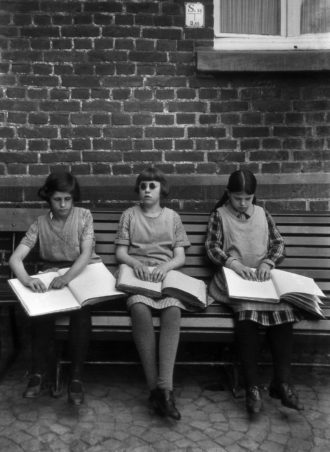
August Sander, photography. (school for the blind).
The subject of pain, then, returns in all of western costumes, and the sense of class and gender intersecting. For there is always a layer in the deconstruction of fashion that incompasses or re-inscribes suffering. Nothing is really a distraction in the end, unless it is part of a campaign of distraction, and that is what education is for, I guess. The attribute of anonymity is a marketing tool, but also a new brand of individuality. And it is eroticized. The eroticizing of Thanatos fits into the creation of an individuality that wont trigger surveillance protocols. The fascist style has incorporated elements from (and perhaps helped create) the post modern digital world, and from various right wing actors (the Christian right certainly) and Hollywood has gone a long ways to domesticate anything even remotely smacking of dissidence or radical politics. Images take on lives of their own. The ruling class are repeatedly caught out in failed appropriations. And this is also the cunning of nostalgia, in a sense. The return of the discarded. Throughout, though, one sees today an erasure of the human. Most obviously in the erasure of the face.
“To experience the aura of a phenomenon means to invest it with the capability of returning the gaze.”
Walter Benjamin
No philosopher has spent more time considering the importance of the human face than Wittgenstein. In fact he saw the very foundations of meaning in the physiognomy of the face. Or rather that meaning is a physiognomy. The inability to read the expressions in someone’s face was likened to tone deafness.
“One may note an alteration in a face and describe it by saying that the face assumed a harder expression – and yet not be able to describe the alteration in spatial terms. This is enormously important.”
Wittgenstein

August Sander, photography. Germany 1938.
“…I suggest, because Wittgenstein regards blindness to the face’s expressions as internally related to the blindness we might display towards emotional expressiveness in art. It follows as well, though, that such blindness to aesthetic expression will be no less a standing possibility, and even temptation, than the possibility of our being soul-blind with respect to one another. There is nothing to stop us from regarding artworks as void of intrinsic expressive life, just as there is nothing to stop us from seeing the human face as without intrinsic psychological expressiveness. Indeed, “expression-blindness,” to give this condition a name, appears to be a widespread and particularly powerful temptation in modern culture and philosophy. It is attested to no less by the numerous modern artworks about faces that portray them as masks, screens, or opaque enigmas…”
Bernie Rhie
In Sartre’s novel Nausea (noted by Rhie) there is a character who often has trouble recognizing faces in the street. This is an increasingly common condition. It is a commonplace that eye witnesses are the least reliable form of evidence in criminal trials. My guess is that this has never been more true. In the age of botox, the face is examined for imperfections, and the frozen countenance of the couture model is a desired attribute. No face and no real. Expression is not tidy. The diminished and degraded idea of the human is another (among other things) that is included in the new fascist charter on style. And style itself is belittled as unworthy of consideration, really. There is a stark refusal to admit the image into discourse other than to discuss its unimportance. Considerations of appearance are lumped in with abuse and intolerance. The return of eugenics speaks to a disfigured latent and subterranean life that reading facial expressions has had, for the eugenicist has stamped on the idea of Nature his or her own face — and that face is disappearing, as all faces are in contemporary culture anyway. The idea of masks, then, has also returned, as photoshopping partly. The unreturned gaze that Benjamin wrote of has become the misplaced face. The lost human.

Jan Van Eyck (Arnolfini, detail; 1434).

Interesting piece, yet again you fixate on how culture thinks about culture in the modern, on civilizational neuroses born of power struggles and how these struggles are manifested in art/advertising/spectacle. As usual this takes the form of a critique of capitalism. But you still dont get to the root of the human problem…. the root that freud and marx never address. becker and rank were the only modern western thinkers to do it. Freud and marx are limited tools for analyzing the core problems, which is probably why you sound so frustrated. It is true that capitalism is a wish “for another life.” But your socialism is a wish for another world. This is obvious because you never address the single biggest elephant in the room. Forget freud and marx for a tad, go read becker.
Thats just rubbish zan. Becker is ok. Ive quoted him a few times here. How old are you? I hope you’re young. Thats the only excuse.
Rank reminds me of that joke about Wagner. He’s better than he sounds. And Verdi isn’t as good as he sounds. Rank is sort of like wagner.
Interesting thoughts on the meaning of the stiletto. I’ve been having similar thoughts about sunglasses – to speak of “the unreturned gaze” ha. Perhaps sunglasses are the masculine-coded version of the same phenomena, the outermost and minute expression of the fascistic core. Just think of how ubiquitous sunglasses are among the military, the police, the secret service, etc.
I think capitalism is the “root of the human problem,” at least until we can leave it behind. Then we can deal with the “stem and branches of the human problem” — the sores and afflictions capitalism has left us with. After a day of voluntarily digging thistle roots from a community permaculture garden, I feel some physical justification in this view.
The sexual stimulus of the bound foot and the stiletto heel is that the woman can’t run. Not more than a few token steps anyway. Whether her condition is externally imposed and permanent or self-chosen and temporary.